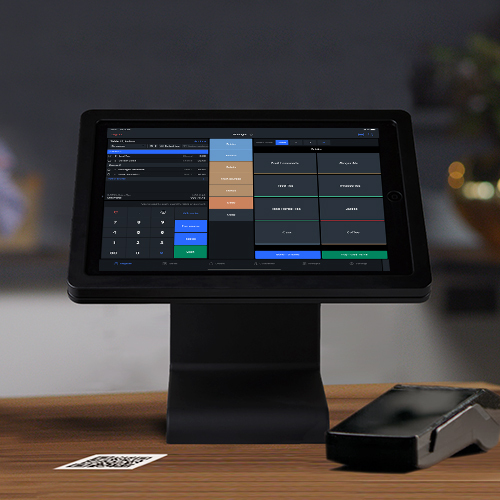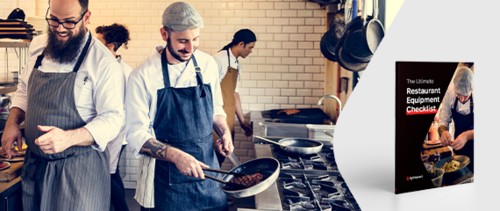
“Where can I take my business next?”
It’s a question any restaurant owner is likely to ask themselves at some point in their career. Seeing that your business is growing but not knowing how best to expand can be a sticky problem.
Luckily, we live in a time where there are more options for diversifying your offering, reaching new customers and developing your business than ever before.
One of these options is starting a ghost kitchen, and it’s become all the more popular in recent years. But how do you start a ghost kitchen? That’s what this post is about.
What is a ghost kitchen?
How to start a ghost kitchen
Pros and cons of a ghost kitchen
Transform your business with Lightspeed
Want to simplify, scale and ignite your potential? Find out what Lightspeed Restaurant ePOS can do for you.

What is a ghost kitchen?
A ghost kitchen, also known as a dark kitchen, is a kitchen without a restaurant. It’s a brand that exists entirely online and for the sole purpose of producing meals for delivery. That means they cannot be found at brick-and-mortar locations and customers can’t sit down for a meal.
Dark kitchen brands can only be accessed through online delivery platforms like UberEATS and Deliveroo. Many restaurants opened dark kitchens in response to lockdowns and dine-in restrictions brought by the pandemic. But the concept is here to stay.
Shared ghost kitchen
Ghost kitchens don’t necessarily need to house just one restaurant or concept. A ghost kitchen might house different brands from the same company, or even entirely different restaurants. Some of these rented spaces might offer anything from kitchen infrastructure to complete restaurant management. Some kitchens require individual brands or restaurants to provide their own staff or they provide staff for you.
Turnkey ghost kitchen
With a turnkey solution, an external company handles all of your ghost kitchen production. That includes setting up the kitchen, handling food preparation, delivery and even expansion. Turnkey solutions might be a great option for a restaurant that’s just starting out and trying out a completely new concept.
How to start a ghost kitchen in 7 steps
- Find your niche
- Develop a product
- Build a brand
- Choose a location
- Plan a kitchen layout
- Get the right tech
- Find staff
1. Find your niche
Low overhead and labour costs give ghost kitchens an advantage over their more traditional competitors. But that doesn’t mean you can rest on your laurels since you won’t be the only one out there. The ghost kitchen market is set to grow to $71.4 billion by 2027. Setting your brand apart is crucial if you’re going to earn your share.
For that reason, the first step to opening a ghost kitchen is finding a niche in the market to fill. Whether you’re starting from scratch or building upon your existing business, ask yourself these questions:
- What are we good at?
- What can we offer that other’s can’t
- Is there someone already doing it and, if so, how can we do it better or differently?
2. Develop a product
Okay, so you’ve dreamt up a winning product—now it’s time to turn it into a reality. You may need to spend some time in the kitchen for this, and call upon your friends in the industry for taste testing and recipe development.
Consider the food cost of your products, and let that decide what price you’ll charge customers in order for you to turn a profit.
Think hard about how you can develop something that’s
- Delicious and in-demand.
- Easy to cook at high volumes.
- Travels well and won’t be spoiled upon arrival.
- Can be sold at a price that consumers can afford while still bringing profit.
3. Build a brand
So you’ve got a niche to fill and a delicious product to sell, now you need a brand. This can be the same brand as your existing business, or a completely new one (if you’re selling different products.)
Your brand is closely tied to your product, so think about how your product appeals to people, and how your brand can emphasise that appeal.
Think of a name, a logo and a brand identity that fits your unique offering. Get on social media and start building a community and brand awareness so people know that you exist and want to buy your stuff.
4. Choose a location
Your ghost kitchen won’t go very far if there’s no actual kitchen. That’s why the next step in this checklist is to find a location.
Since a ghost kitchen is solely about delivery, be sure to pick a ‘hub’ location from where you can serve the optimum number of customers and the lowest cost to your business.
Since you’re not a physical restaurant, you don’t have to consider footfall as a factor in success. Hell, you could even open up right next to a competitor and it wouldn’t make much difference. Success depends more on whether customers can find you online and how quickly and professionally you can serve them.
The location you choose may depend on the space available to you.
Start a ghost kitchen from your existing business location
Using your existing kitchen space may save you the cost of finding a completely new location. However, your kitchen may not have the capacity to handle the increase in order volume a ghost kitchen could trigger. Therefore, you risk jeopardising your on-premise operations to accommodate your off-premise ones. That could overwhelm your staff, eat through your inventory and ultimately hurt your business.
Rent out a ghost kitchen space
This could allow you to position your ghost kitchen more strategically. Many dark kitchens move into low rent space that they share with other brands or businesses, so that utility costs are spread thin.
5. Plan a kitchen layout
You’re not operating a traditional restaurant kitchen. That means the layout of your ghost kitchen will be a little different to what you might be used to. The function of the pass, for example, changes from where waiters collect dishes to where drivers receive food packages.
Get the right equipment for your kitchen
Get set up with our comprehensive restaurant equipment checklist

You also won’t need things like plates but should invest in plenty of food packaging to store it while it travels.
Ensure you have some kind of waiting area within your dark kitchen space where waiting drivers can sit and protect themselves from the elements.
6. Get the right tech
For all their differences, there isn’t much restaurant equipment you’d need for a ghost kitchen that you wouldn’t find in a traditional one. There is, however, certain tech you can use to make your workflow way easier.
Consider investing in a point of sale system that lets you sync your ghost kitchen menu to major food delivery apps and receive orders on one iPad (nothing worse than having a separate iPad for each delivery platform)
7. Find staff
Ghost kitchens eliminate the need for front-of-house staff, which could have a positive effect on your labour costs. But you still need to hire chefs and train them on your menu.
In your product development stage, you should have formalised the recipes for your menu and how they should be cooked. Make sure this is clearly communicated to staff so that you can keep your food costs down and profit margins high.
Pros and cons of a ghost kitchen
Pros
Lower overhead costs
Without a storefront, ghost kitchens avoid all the overhead costs associated with buying or leasing a commercial restaurant space. If you want to update your menu, you don’t need to re-print anything. Just make updates online and you’re all set.
Easier to launch
Compared to opening an on-premise dining restaurant, ghost kitchens can be relatively quick to set up. While you can opt for leasing a space and getting started by yourself, there are also companies that offer leasing services for spaces designed for ghost kitchens and some even offer turnkey operations with all the equipment you might need.
Less risk
Since you’re reducing your overhead costs and aren’t hosting people in a restaurant setting, you’re already reducing a lot of the typical risks associated with launching your own restaurant. Like all businesses in the hospitality industry, having a ghost kitchen still has inherent risks, but you can choose to further minimize those risks by working with companies that provide turnkey operations, staff, expertise, etc.
Expand delivery range
A ghost kitchen can also be a great way to test a new market. If you only have one restaurant location or are using specific third-party delivery platforms, your delivery range will have some limits. If you want to expand your customer base, opening a ghost kitchen in another location can help you increase production and offer delivery-only services to new areas.
Capitalize on increasing demand for online ordering
Ghost restaurants can sell through as many third-party delivery services as they want as well as through their website.
Cons
Third-party delivery aggregator fees
It’s no secret that third-party delivery aggregators collect a transaction and/or service fee on each sale made on their platform. If left unchecked, this can certainly take away from a restaurant’s net profits. If you’re looking to start a ghost restaurant but don’t want the fees that come with third-party delivery platforms, you might want to think of offering your own delivery service. In-house delivery solutions like Order Anywhere, lets restaurants take full control over their delivery operations, avoid third-party fees and lets customers order online for delivery.
Reputation management
With no customer-facing service, a ghost restaurant’s reputation relies heavily on word of mouth and online reviews. Actively promoting positive reviews and responding to negative ones is a must for ghost restaurants.
Increased pressure on marketing
Brand-building in a strictly online space, without a brick and mortar location to drive awareness, makes effective digital marketing key to customer acquisition.
Limited customer base
Since a ghost kitchen is an off-premise restaurant model, you will be limited to delivery or takeout only customers. You might also face limits in your delivery range depending on the third-party platforms you use.
Get the right tools for your ghost kitchen
Success starts with preparation. Talk to one our experts to see how Lightspeed can propel your business forward today.

News you care about. Tips you can use.
Everything your business needs to grow, delivered straight to your inbox.


